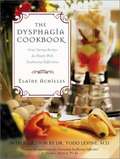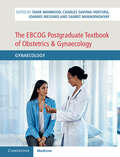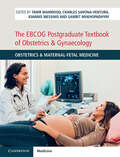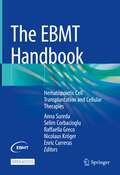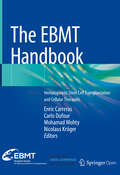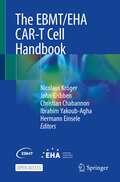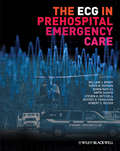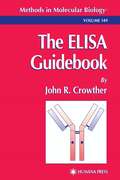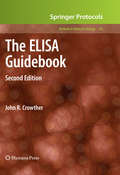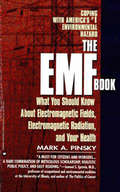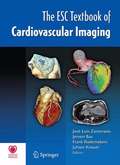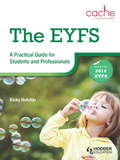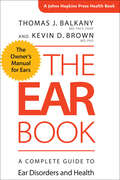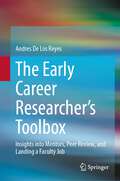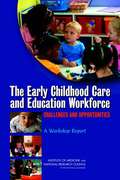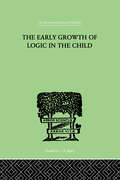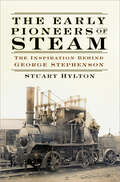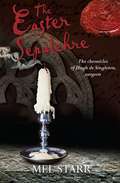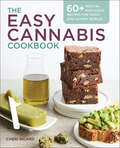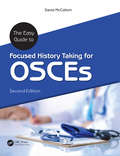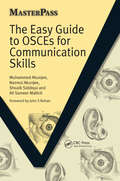- Table View
- List View
The Dysphagia Cookbook: Great Tasting And Nutritious Recipes For People With Swallowing Difficulties
by Elayne Achilles Todd Levine<P>The Dysphagia Cookbook is a specialty cookbook filled with nutritious, great-tasting recipes for those whose eating options are limited by chewing and swallowing difficulties. <P>All of the recipes focus on enhancing flavor, presentation, texture, aroma, and color, for there are many other products that supply nutritious calories or liquids but give little attention to these quality-of-life concerns.
The EBCOG Postgraduate Textbook of Obstetrics & Gynaecology: Gynaecology
by Tahir Mahmood Sambit Mukhopadhyay Charles Savona Ventura Ioannis MessinisThis authoritative textbook provides a much-needed guide for postgraduate trainees preparing for the European Board and College of Obstetrics and Gynaecology (EBCOG) Fellowship examination. Published in association with EBCOG, it fully addresses the competencies defined by the EBCOG curriculum and builds the clinical practice related to these competencies upon the basic science foundations. Volume 2 covers the depth and breadth of gynaecology, and draws on the specialist knowledge of four highly experienced Editors and over 100 contributors from across Europe, reflecting the high-quality training needed to ensure the safety and quality of healthcare for women. It incorporates key international guidelines throughout, along with colour diagrams and photographs for easy understanding. This is an invaluable resource, not only for postgraduate trainees planning to sit the EFOG examination, but also for practising specialists looking to update their knowledge and skills to meet the ever-evolving complexity of clinical practice.
The EBCOG Postgraduate Textbook of Obstetrics & Gynaecology: Obstetrics & Maternal-Fetal Medicine
by Tahir Mahmood Sambit Mukhopadhyay Ioannis Messinis Charles Savona-VenturaThis authoritative textbook provides a much-needed guide for postgraduate trainees preparing for the European Board and College of Obstetrics and Gynaecology (EBCOG) Fellowship examination. Published in association with EBCOG, it fully addresses the competencies defined by the EBCOG curriculum and builds the clinical practice related to these competencies upon the basic science foundations. Volume 1 covers the depth and breadth of obstetrics, and draws on the specialist knowledge of four highly experienced Editors and over 100 contributors from across Europe, reflecting the high-quality training needed to ensure the safety and quality of healthcare for women and their babies. It incorporates key international guidelines throughout, along with colour diagrams and photographs for easy understanding. This is an invaluable resource, not only for postgraduate trainees planning to sit the EFOG examination, but also for practising specialists looking to update their knowledge and skills to meet the ever-evolving complexity of clinical practice.
The EBMT Handbook: Hematopoietic Cell Transplantation and Cellular Therapies
by Raffaella Greco Enric Carreras Nicolaus Kröger Anna Sureda Selim CorbaciogluThis Open Access new edition of the EBMT handbook with its new format, addresses the latest developments and innovations in hematopoietic cell transplantation and cellular therapy. Consisting of 94 chapters, it has been written by 210 leading experts in the field. Discussing all types of hematopoietic cell transplantation, including selection of stem cell sources, it also covers the indications for transplantation, the management of early and late complications as well as the new and rapidly evolving field of cellular therapies and new infections (COVID-19). This book provides an unparalleled description of current practices to enhance readers’ knowledge and practice skills.
The EBMT Handbook: Hematopoietic Stem Cell Transplantation
by Mohamad Mohty Enric Carreras Carlo Dufour Nicolaus KrögerThis Open Access edition of the European Society for Blood and Marrow Transplantation (EBMT) handbook addresses the latest developments and innovations in hematopoietic stem cell transplantation and cellular therapy. Consisting of 93 chapters, it has been written by 175 leading experts in the field. Discussing all types of stem cell and bone marrow transplantation, including haplo-identical stem cell and cord blood transplantation, it also covers the indications for transplantation, the management of early and late complications as well as the new and rapidly evolving field of cellular therapies. This book provides an unparalleled description of current practices to enhance readers’ knowledge and practice skills.
The EBMT/EHA CAR-T Cell Handbook
by Nicolaus Kröger John Gribben Christian Chabannon Ibrahim Yakoub-Agha Hermann EinseleThis first open access European CAR-T Handbook, co-promoted by the European Society for Blood and Marrow Transplantation (EBMT) and the European Hematology Association (EHA), covers several aspects of CAR-T cell treatments, including the underlying biology, indications, management of side-effects, access and manufacturing issues. This book, written by leading experts in the field to enhance readers’ knowledge and practice skills, provides an unparalleled overview of the CAR-T cell technology and its application in clinical care, to enhance readers’ knowledge and practice skills.
The ECG in Prehospital Emergency Care
by Robert Reiser Robin Naples Amita Sudhir William J. Brady Jeffrey Ferguson Korin Hudson Steven MitchellNow that state of the art equipment can be carried in ambulances, prehospital emergency staff are able to perform an ECG soon after arrival on scene, enabling the EMS provider to gather important diagnostic information that can not only guide prehospital therapy but also direct hospital-based treatment. This book exclusively addresses ECGs for prehospital emergencies, ranging from basic rhythm diagnosis to critical care applications of the electrocardiogram and advanced 12-lead ECG interpretation in the ACS patient. It provides self testing traces covering all these conditions seen in prehospital and hospital- based environments. It includes 200 randomly presented cases mirroring real life situations, with the answers set out separately together with additional invaluable information.Written by highly experienced emergency physicians with EMS qualifications and experience, this text is an ideal learning tool for trainees and fully qualified staff alike, including ground EMS advanced life support providers, aeromedical staff, and inter-facility critical care transport personnel.
The EKG Workbook: Becoming Proficient in Reading EKGs by Reading EKGs
by Aaron J. GindeaMaster the challenging EKG interpretation process and confidently prepare for your clerkship! The EKG Workbook: Becoming Proficient in EKGs by Reading EKGs gives you hands-on practice applying core knowledge to reach accurate interpretations with ease. Each EKG practice strip is labeled based on difficulty and is accompanied by a fully annotated, color-coded interpretation, empowering you to improve your proficiency at your own pace and build the confidence for success from your board review to clinical practice.
The ELISA Guidebook
by John R. CrowtherHighly sensitive, precise, and versatile, Enzyme Linked Immunosorbent Assay (ELISA) is now the predominant assay used in biomedical and agricultural research, as well as in applied science. In The ELISA Guidebook, John R. Crowther provides todayís premier practical guide to the understanding and application of ELISA. Updating and greatly expanding his widely appreciated earlier publication, ELISA Theory and Practice (1995), this important work introduces such major new topics as checkerboard titrations, quality control of testing, kit production and control, novel monoclonal antibodies, validation of assays, statistical requirements for data examination, and epidemiological considerations. The author describes each method in great detail to ensure experimental success and includes advice on equipment choice, maintenance, and calibration. Wherever possible, helpful written explanations are provided along with copious diagrams. With its numerous worked examples, detailed instructions, and extensive illustrations, The ELISA Guidebook offers a powerful synthesis of all the basic concepts and practical experimental details investigators need to understand, develop, and apply the new ELISA methodology successfully in day-to-day basic and clinical research.
The ELISA Guidebook, 2nd Edition
by John R. CrowtherThe Enzyme Linked Immunosorbent Assay (ELISA) continues, as predicted, to be the predominant assay used in biomedical and agricultural research. While little has changed in the principles of the ELISAs used since the publication of The ELISA Guidebook, many technological advantages, including the increasing number of reagents available for exploitation and the larger spectrum of instruments to measure the coloured products of ELISAs, have greatly benefited the field. Other testing technologies using molecular techniques, predominantly the conventional and more and more often, real time PCR, are rapidly evolving to help diagnose and differentiate disease agents and identify substances present in exquisitely small amounts. The ELISA is still needed either alone in mass screening, such as serological assays, or used in tandem with molecular techniques to fully evaluate the molecular and antigenic nature of analytes.<P><P> John R. Crowther provides today's premier practical guide to the understanding and application of ELISA. This Edition enlarges on charting methods for assessing the indirect ELISA, ruggedness and robustness of tests, aspects of kit use and validation, and internal quality control and external quality management of data. The author describes each method in great detail to ensure experimental success and includes advice on equipment choice, maintenance, and calibration. Wherever possible, helpful written explanations are provided along with copious diagrams.<P><P> With its numerous worked examples, detailed instructions, and extensive illustrations, The ELISA Guidebook, Second Edition offers a powerful synthesis of all the basic concepts and practical experimental details investigators need to understand, develop, and apply ELISA methodology successfully in day-to-day basic and clinical research.
The EMF Book: What You Should Know About Electromagnetic Fields, Electromagnetic Radiation, and Your Health
by Mark A. PinskyA guide to what EM fields are, what the risks are and what you can do about it.
The ESC Textbook of Cardiovascular Imaging
by Jeroen J. Bax Frank E. Rademakers Jose Luis Zamorano Juhani Knuuti"The ESC Textbook of Cardiovascular Imaging" is a comprehensive guide to all forms of cardiovascular imaging. A disease based approach is followed and the book is comprised of 8 sections. Section 1 describes the imaging techniques available and Sections 2-8 describe the imaging modalities used to visualise cardiovascular diseases in seven main areas. Each section is subdivided into 2-7 chapters. The book is edited by four European opinion leaders in the fields of echocardiography, nuclear, CMR and CT imaging and has over 50 contributors, mainly from Europe. The printed version is complemented by a basic online version, accessible by means of a password, distributed with the book. The online version allows users to: download chapters for ease of use; provide links from all references to PubMed; allow searching of the text; and download figures and images for non-commercial use in PowerPoint presentations.
The EYFS: A Practical Guide for Students and Professionals
by Vicky HutchinEndorsed by CACHE, this is the ideal book for you if you are an early years professional, a Level 2 or Level 3 child care learner, are working in a pre-school or are working as a child minder. This book will de-mystify the revised 2012 Early Years Foundation Stage, and show how you can deliver the new EYFS using the best and most effective standards of professional practice.Each chapter explains a key theme of the EYFS and follows the same model to ensure ease of reading: 'Understanding this theme', 'Looking at children', 'What the experts say' and 'Effective practice'.The most important theory and research relating to each aspect of the EYFS is clearly and simply explained, and suggestions as to how this can influence effective practice are included.Links between child development and the EYFS are demonstrated using carefully analysed observations of children at different ages, highlighting not only common themes but also the uniqueness in every child's learning and development. Case studies in every chapter provide practical examples of best practice and activities help you reflect on and develop your own practice.
The Ear Book: A Complete Guide to Ear Disorders and Health (A Johns Hopkins Press Health Book)
by Thomas J. Balkany Kevin D. BrownThe owner’s manual for ears.Intricately shaped and amazingly sensitive, ears are the organs of hearing and balance. When something goes wrong with the ears—whether infection or cancer, eardrum perforation or hearing loss—our overall well-being is generally disturbed.In The Ear Book, Drs. Thomas J. Balkany and Kevin D. Brown, recognized experts on ears and hearing, explain how the anatomy of the ear facilitates hearing and balance and then examine the causes, symptoms, and treatment of common problems of the outer, middle, and inner ear. Their explanations take the mystery out of hearing aids, the proper care of ears, and how the pressurized conditions of scuba diving and air travel affect the ears. And they debunk ear-related myths—from the notion that exposure to loud noise strengthens the ear to the idea that tinnitus can be cured with nutrients—and urge readers to stop using ear candling or Q-tips to get rid of wax.Drs. Balkany and Brown address such common questions as: Can dizziness be cured? How loud is too loud? Why do my ears ring? Do cochlear implants work for nerve deafness? What promise do innovations in gene therapy and stem cell therapy hold for the future? Fully illustrated and including helpful tables, hearing preservation tips, a glossary of terms, lists of ear medications and resources, and suggestions for further reading, The Ear Book is sure to be a welcome family guide.
The Ear Book: A Complete Guide to Ear Disorders and Health (A Johns Hopkins Press Health)
by Thomas J. Balkany Kevin D. Brown“Everything you ever wanted to know about ears from two outstanding physician scientists. I loved this book!” —Donna Shalala, Former U.S. Secretary of Health and Human ServicesIn The Ear Book, Drs. Thomas J. Balkany and Kevin D. Brown, recognized experts on ears and hearing, explain how the anatomy of the ear facilitates hearing and balance and then examine the causes, symptoms, and treatment of common problems of the outer, middle, and inner ear. Their explanations take the mystery out of hearing aids, the proper care of ears, and how the pressurized conditions of scuba diving and air travel affect the ears. And they debunk ear-related myths—from the notion that exposure to loud noise strengthens the ear to the idea that tinnitus can be cured with nutrients—and urge readers to stop using ear candling or Q-tips to get rid of wax.Drs. Balkany and Brown address such common questions as: Can dizziness be cured? How loud is too loud? Why do my ears ring? Do cochlear implants work for nerve deafness? What promise do innovations in gene therapy and stem cell therapy hold for the future? Fully illustrated and including helpful tables, hearing preservation tips, a glossary of terms, lists of ear medications and resources, and suggestions for further reading, The Ear Book is sure to be a welcome family guide.“This book is gem for everyone with questions about their ears. I highly recommend it—especially the chapter on Myths of the Ear!” —D. Bradley Welling, MD, PhD, Harvard University Department of Otolaryngology
The Early Career Researcher's Toolbox: Insights into Mentors, Peer Review, and Landing a Faculty Job
by Andres De Los ReyesThis book probes professional development issues crucial to early career researchers, beginning with advice on selecting mentors and optimizing mentoring relationships. From this foundation, the book describes how to navigate the peer-review process, particularly when publishing in academic journals, as well as build connections between the different pieces of academic work published during the early career years. It details strategies to leverage the tools of storytelling to build a research program coupled with concrete guidance on delivering job talks during academic job interviews. In addition, the book includes a feature, Anonymous Accounts, which provides real-life examples of how early career researchers experienced many aspects of their training and illustrates how to overcome obstacles on the path to success in the academic job market.Key topics featured include: Selecting and working with mentors. Navigating peer review when publishing in academic journals. Building a research program. Delivering academic job talks. The Early Career Researcher’s Toolbox is a must-have resource for graduate students, post-doctoral fellows, and aspiring undergraduate students as well as all early career and other professionals in search of a resource designed to help them succeed in the academic job market.
The Early Childhood Care and Education Workforce
by Institute of Medicine National Research Council Division of Behavioral and Social Sciences and Education Board on Children, Youth and Families Committee on Early Childhood Care and Education Workforce: A WorkshopEarly childhood care and education (ECCE) settings offer an opportunity to provide children with a solid beginning in all areas of their development. The quality and efficacy of these settings depend largely on the individuals within the ECCE workforce. Policy makers need a complete picture of ECCE teachers and caregivers in order to tackle the persistent challenges facing this workforce. The IOM and the National Research Council hosted a workshop to describe the ECCE workforce and outline its parameters. Speakers explored issues in defining and describing the workforce, the marketplace of ECCE, the effects of the workforce on children, the contextual factors that shape the workforce, and opportunities for strengthening ECCE as a profession.
The Early Growth of Logic in the Child: Classification and Seriation (International Library Of Psychology Ser.)
by Inhelder, Brbel & Piaget, JeanFirst published in 1999. Routledge is an imprint of Taylor & Francis, an informa company.
The Early Pioneers of Steam: The Inspiration Behind George Stephenson
by Stuart HyltonWe think of the Stephensons and Brunel as the fathers of the railways, and their Liverpool and Manchester and Great Western Railways as the prototypes of the modern systems. But who were the railways’ grandfathers and great-grandfathers? The rapid evolution of the railways after 1830 depended on the juggernauts of steam locomotion being able to draw upon centuries of experience in using and developing railways, and of harnessing the power of steam. Giants the Stephensons and others may have been, but they stood upon the foundations built by many other considerable – if lesser-known – talents. This is the story of those early pioneers of steam.
The Easdale Doctor: The Life and Times of Patrick H. Gillies
by Mary WithallAn inspiring biography of a Victorian-era physician who gave up the promise of fortune and glory to serve his small community on a Scottish island. When Patrick Gillies graduated from the University of Edinburgh&’s distinguished school of medicine with honors in 1890, a high-profile career as a surgeon lay ahead of him. Any city across the world would have welcomed him, and his university mentors, including the famous Joseph Lister, urged him to take up one of these opportunities. But Gillies defied them all and returned to his hometown of Easdale, determined to continue the work his father had begun as a physician to the parishioners of Scotland&’s Slate Islands. Over the next forty years, Patrick Gillies worked tirelessly to sustain and improve the community. While working as a General Practitioner, he involved himself in the needs of Easdale, fighting the closure of the local school as a member of the school board, and applying his expertise and determination to public health issues, working to build an isolation hospital and provide better medical care for children. Eventually, he would serve his country as well, in Army service in two wars. This biography is a portrait of a quiet hero, a tale of a dedicated doctor who stayed in a small town—and made a big difference.
The Easter Sepulchre: The Thirteenth Chronicle of Hugh de Singleton, Surgeon (Hugh de Singleton, Surgeon #13)
by Mel StarrKeeping watch over the Easter Sepulchre, where the Host and crucifix are stored between Good Friday and Easter Sunday, is considered a privilege. So, it is shocking when it is discovered that Odo, the priest’s clerk, has abandoned his post. But as the hours pass and Odo is not found, Hugh de Singleton is called upon. It is Hugh that finds the dried blood before the altar, and fear grows for the missing man... Will Hugh be called upon to investigate another murder, or will the man be found hale and hearty? But if so, where has the blood come from?
The Easy Cannabis Cookbook: 60+ Medical Marijuana Recipes for Sweet and Savory Edibles
by Cheri SicardThe definitive guide to making easy, everyday ediblesGo beyond just cookies and brownies as you learn how to serve up delicious edibles perfect for every meal with this comprehensive exploration of cooking with cannabis.Written by Cheri Sicard—nicknamed the "Martha Stewart of weed" by The Daily Beast—this cannabis cookbook provides you with absolutely everything you need to redefine stoner eats. Whether it's Ganja Gazpacho, Barbecue Chicken, or Deviled Eggs, these simple and straightforward recipes make it a breeze to bring unique, properly dosed edibles to the table.This must-have marijuana cookbook includes:Cannabis 101—Discover a crash course on the history of marijuana and all the benefits it provides.Dosing guides—Find out how to measure potency and make sure your infusions meet their mark.Cooking fundamentals—Learn fundamental cooking skills, what equipment you need, and more.60 Tasty recipes—Go beyond cookies and brownies with recipes for breakfasts, lunches, dinners, and more.Get baked, roasted, and grilled cannabis-infused treats for every meal thanks to The Easy Cannabis Cookbook.
The Easy Guide to Focused History Taking for OSCEs, Second Edition
by David MccollumThis straightforward guide to taking patient history comprehensively covers all of the commonly seen OSCE scenarios within the current undergraduate medical curriculum. The Easy Guide to Focused History Taking for OSCEs includes introductory chapters with general OSCE guidance, mapping onto the Calgary-Cambridge model. These include tips from recently qualified doctors and highly respected physicians and surgeons who commonly examine OSCEs, as well as a sample OSCE marking scheme. ? The book then covers 56 histories based on presenting complaints - more than any other text on the market - thoroughly testing both knowledge and examination technique. Each history is based around the exam requirements, with mnemonics, ‘red flag’ symptom boxes and list-based breakdowns to aid prompt recall. Common and serious differentials are highlighted, as well as investigations to help rule out the serious conditions. Each section concludes by outlining key aspects for each differential diagnosis as well as a list of investigations and management options. ? With this book, every student will be well equipped to tackle any clinical problem, in the OSCE examination and also in their continued professional practice.
The Easy Guide to OSCEs for Communication Skills
by Muhammed Akunjee Nazmul Akunjee Shoaib Siddiqui Ali Sameer MallickIt is increasingly recognised that communication plays a pivotal role in obtaining successful clinical outcomes. However, despite an increase in communication skills teaching, much of literature on this topic is targeted at senior doctors and researchers, and many medical students still find demonstrating competence in communication skills OSCEs a challenge. This book lightens the load by simplifying communication skills, explaining key theories and concepts simply and illustrating them through practical role plays. It covers a wide variety of common dilemmas in clinical and examination settings, and tackles challenging and increasingly familiar areas such as cross-cultural sensitivities, communicating with a patients whose first language is not English, and communicating with patients who have complaints about their treatment.
The Easy Guide to OSCEs for Final Year Medical Students, Second Edition (MasterPass)
by Muhammed Akunjee Nazmul Akunjee Dominic Pimenta Dislan YilmazThe final year Objective Structured Clinical Examinations (OSCEs) test a broad range of practical skills, knowledge, examination technique and communication abilities, and can be a daunting prospect. The Easy Guide to OSCEs for Final Year Medical Students covers, in a self-assessment format, over 99 sample OSCE stations including the standard history, examination and general skills stations. This edition includes additional commonly examined cases and instruction on how to interpret a paper. With newly created colour illustrations and clinical photographs, the clear layout and easy-to-read style prepares students for the examination environment and focuses on the specific areas and responses examiners look for.
